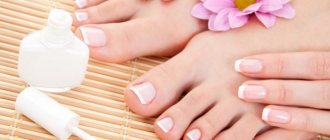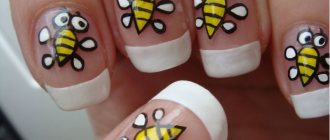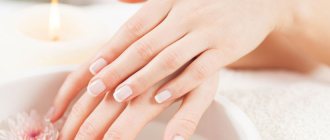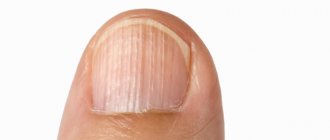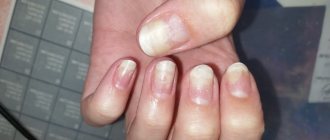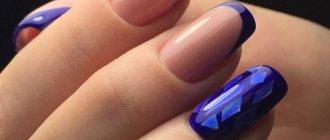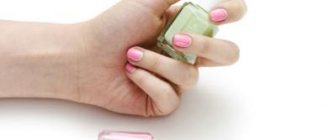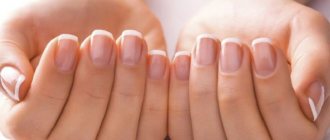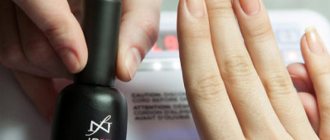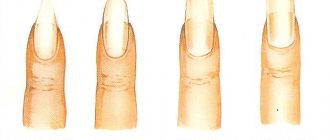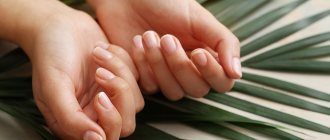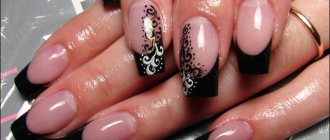Waves on the nail plates occur at any age . In addition to the unpleasant aesthetic appearance, a person’s self-esteem suffers. This is a pronounced problem for which it is necessary to consult a doctor for consultation and timely treatment.
The doctor will be able to judge the general condition of the body by looking at the nails . But you shouldn’t feel discouraged when your nails become wavy. Eliminating the causes and timely treatment will allow your nails to return to their usual appearance and give your hands beauty.
Let's take a closer look at the topic of wave nails: causes and treatment.
Causes
An uneven nail can have pronounced or almost imperceptible waves.
Stages of plate deformation:
- cracks and pits appear;
- the plate becomes uneven;
- the surface loses its integrity.
There are several important factors that influence the formation of waves on the nails.
Main reasons:
- External . Use of low-quality materials for nail extensions, burns from a UV lamp.
- Household chemicals . Detergents have a negative effect on the skin of your hands and nails.
- Injuries . Performing a manicure with low-quality tools that can destroy the treated area of the plate, bruises, cutting off burrs, pinching.
- Infectious diseases . The fungus leads to disruption of the structure of the nails, making them thin.
- Diseases of internal organs . Metabolic failure leads to changes in the functioning of the endocrine system, which affects the entire body.
- Lack of vitamins . Most often, it is the lack of iron and calcium that causes the destruction of the plate, as a result of which the nails become wavy, brittle and thin.
- Hormonal changes . Pathologies of the thyroid gland cause deformation of the nails.
- Stress, nervous tension . A depressive state causes an imbalance in the functioning of all body systems.
If the appearance of the nails has changed, it is necessary to undergo an examination to find out the cause of the disease. This allows you to choose the right and timely treatment.
Paronychia - purulent inflammation around the nail
Paronychia is an inflammation of the periungual fold, that is, the skin and soft tissue that frames and supports the nail, one of the types of panaritium. The cause of paronychia is infection, and the predisposing factor is trauma. The disease is approximately three times more common in women. Sometimes paronychia is caused by a chronic skin condition such as eczema or psoriasis, or another disease such as diabetes or HIV.
Paronychia can be acute, where symptoms appear within a few hours, or chronic, lasting longer than six weeks.
Acute paronychia
Acute paronychia usually develops as a result of minor damage to the periungual fold, for example, during a manicure or in those who like to bite their nails. The affected area becomes red, hot and painful to the touch, and swollen. After some time, pus may appear and accumulate around the nail.
The most common cause of acute paronychia is the bacterium Staphylococcus aureus, although any other microbes can also cause inflammation. In rare cases, the cause of a periungual infection is the herpes virus, then they speak of herpetic whitlow. The earliest stages of bacterial paronychia are treated with antibiotics, and often resort to surgical opening of the abscess. Without proper treatment, the process can become chronic.
Chronic paronychia
Chronic paronychia may develop more slowly and may be more difficult to get rid of. It is most common among people whose hands frequently come into contact with water or chemicals, such as cleaners, bartenders, kitchen workers or fishmongers. The disease can begin on one nail, but then affect several. The affected periungual folds become swollen and can sometimes become red and painful, often after contact with water. The nail plate gradually thickens and grooves appear on it, and the nail may turn yellow or green and become brittle.
The skin with chronic paronychia is often abundantly populated with fungi and bacteria, the reproduction of which is normally restrained by the immune system, and against the background of the disease they feel great. In order to cure chronic paronychia, complex treatment is necessary, which may take several months. If cured, it may take up to a year for a healthy nail to grow back. Sometimes you can relieve symptoms by keeping your hands dry and warm, regularly applying moisturizer, and not biting your nails.
Types of waviness
There are two types of waviness on the hands:
- Longitudinal.
- Transverse.
Longitudinal waves are vertical. They pass through the entire plate from the cuticle to the edge.
Reasons for appearance:
- mistakes when doing manicure;
- avitaminosis;
- stressful situations;
- exposure to detergents.
Transverse waves are horizontal and indicate serious disorders in the body. Pathology requires drug treatment.
The waviness in this case is very pronounced and is accompanied by a change in the shade of the nail plate.
Uneven surface of nails in children
Wavy fingernails can also be present in a child, the reasons may be the following:
- The Candida microorganism entered the child’s body through the consumption of poorly processed vegetables and fruits.
- Carbohydrate imbalance due to a lack of vitamins A and B in a child.
- Scratches and peeling of the skin at the edges can provoke an inflammatory process due to infection.
- Colds, pneumonia, and lichen sicca can also affect the structure of a child’s nails.
The nail plate of children differs from that of adults in structure. In a child it is thin and easily damaged. Many children bite their skin, causing hangnails. A child’s cuticle is hypersensitive, and often, when damaged, serves as a favorable environment for the proliferation of yeast parasites. Adults need to disinfect the baby’s nails with an antimicrobial solution, and wash their hands with antibacterial soap after a walk. It is necessary to regularly wipe your hands with disinfectants.
Features of the manifestation of pathology
Uneven fingernails and toenails are accompanied by external and internal symptoms.
Features of manifestation:
- uneven nail plate;
- thinning;
- yellowness;
- pits, bulges;
- nails peel and break;
- white and black dots appear.
Infectious diseases and vitamin deficiency may be accompanied by a deterioration in general health, drowsiness, and loss of strength.
If your nails become wavy over time, this indicates that there is a malfunction in the body. The appearance of a symptom such as lumpiness on the nail plate is associated with infections and a lack of vitamins.
Irregularities in children and adults can be a feature of the body. In this case, cosmetic procedures and manicures help.
The child has
Wavy stripes on a child’s nails are often associated with a lack of vitamins and microelements in the body.
Children are more susceptible to finger injuries than adults . They often pinch the hands and waves form on the thumb.
Diagnosis by nail hole
Holes or lunulae are light areas located at the base of the finger. They, like nails, indicate health problems.
The hole has become thin or disappeared completely:
- The little finger hole is the very first harbinger of the state of the cardiovascular system and metabolic disorders in the small intestine. It is possible that hypertension is developing and it is time to control the pressure. Gastrointestinal symptoms appear (bloating, diarrhea, pain). By the way, over the years, the hole on the little finger disappears for many (I no longer have it on both hands).
- The ring finger, next to the small one, will show the state of the endocrine system. Often during menopause, the hole begins to disappear. It is necessary to regularly check thyroid hormones, the lymphatic system, and women should visit a gynecologist.
- The middle lunula disappears. In this case, heart problems begin, which means the vascular and circulatory system suffers.
- The index finger tells about the condition of the large intestine, pancreas, liver, and gynecological diseases.
- The lunula of the thumb shows the condition of the spleen, lungs and the health of brain activity.
Large
Normally, it should be about 25% of the entire surface of the plate.
If the holes occupy a third of the entire plate, then they are considered large. This is a reason to diagnose the condition of the heart and blood vessels. In hypertensive patients it grows on the little finger.
Pay attention to irregular heart rhythms or other abnormalities. Weakness of the heart muscle has a sign of unnatural enlargement of the holes on all fingers
Large holes are often observed in people who play sports professionally. They also increase in size after suffering stress.
Little ones
If the lunulae barely reach the cuticle, then they are considered small. Reduced in size are:
- low blood pressure;
- problems in the circulatory system;
- weak immunity;
- metabolic disorder;
- with deficiency of iron and vitamin B12;
- diabetes mellitus visually isolates the holes from the common nail plate with a transverse stripe.
- lung problems especially in heavy smokers.
Can not see
Normally, the sockets may not be visible in children. Over time they should appear. Sometimes their absence is a consequence of the physiological characteristics of the nail structure. In this case, there is no need to panic.
Their sudden disappearance should be a cause for concern. As medical observations show, this effect occurs when there is a malfunction:
- thyroid gland;
- iron deficiency anemia;
- vitamin B12 deficiency.
Color change
You need to pay attention to the color of the holes; normally they are white, lighter than the skin. Color changes indicate various disorders:
- Gray - speaks of diseases of the digestive system.
- Purple is a sign of impaired blood supply to tissues and organs. Frequent headaches and dizziness.
- Red color is a marker of lung diseases. The sockets turn red in people who lead a sedentary lifestyle.
- Black. It signals that the body is poisoned by heavy metals.
Sometimes lunulae turn blue in the cold. If they turn pink again in the warmth, there is no cause for concern.
Treatment
Treatment and further prevention are prescribed after diagnosis.
Main stages of treatment:
- Medicines, antibiotics.
- Taking vitamin complexes.
- Revision of nutrition.
- Baths, hand creams, medicinal compositions.
- Hand massage.
Medications
Pharmacological drugs are used when the surface of the nail is damaged due to fungal and infectious diseases. Untimely treatment can lead to the spread of pathology to all nails.
Medications:
- Miconazole ointment (antimicrobial agent).
- Aevit. The plate is strengthened.
- Nicotinic acid, Retinol, Chitin.
- Antibiotics.
Medicines and ointments can only be prescribed by the attending physician. You cannot self-medicate.
Taking vitamins
For healthy nails, it is important to monitor your diet and take vitamin complexes. Nutritionists recommend excluding fatty and fried foods and flour products from the diet.
The following vitamins should be supplied to the body along with foods:
- Group B drugs. Improve the quality of nails and hair. Contained in black currants and broccoli.
- Iron. Participates in providing tissues with oxygen. Contained in beef, liver, tuna, zucchini.
- Fluorine. Makes bone tissue strong. Contained in tomatoes, nuts, citrus fruits.
- Vitamin C. Increases immunity, strengthens the entire body as a whole.
- Sulfur. Gives the plate shine and shine, protects from delamination. Contained in buckwheat, onions, oatmeal.
Baths and compresses
At home, you can take care of your nails no worse than in a beauty salon. Do-it-yourself baths and compresses have a good effect on the quality of the plate.
Sea salt
Salt effectively strengthens nails and accelerates their growth.
Preparation:
- Pour 500 ml of warm water into a small container.
- Dissolve 2 tbsp. l. sea salt.
- If desired, add 1-2 drops of essential oil.
- Place your hands in the bath for 15 minutes.
- Rinse. Lubricate with cream.
The procedure is carried out every 2 days. Do not use salt on wounds and cuts.
Lemon acid
Vitamin C makes nails strong, gives shine and shine.
Preparation:
- Dissolve 2 g of citric acid in a bath of warm water. You can use freshly squeezed lemon juice.
- Dip your fingertips into the liquid for 10 minutes.
- Wash your hands with running water. Apply moisturizer.
The bath is done 1-2 times a week.
Oil compress
Essential oils help get rid of wavy nails and improve their appearance.
Preparation:
- Add 5 drops each of almond, tea tree and avocado oil to olive oil.
- Mix the composition and apply to a cotton pad. Apply the compress to problem areas and hold for 3-5 minutes.
- Wash your hands with warm water.
An oil compress is used daily.
Traditional medicine
Folk remedies are used in combination with the treatment prescribed by the doctor. Deformation of the nail plate will disappear if the procedures are carried out regularly.
Traditional medicine:
- Sunflower oil (must be slightly heated in a water bath and rubbed into the affected areas).
- Oatmeal hand mask. Pour boiling water over the cereal and leave for 30 minutes. Apply the mixture to your hands and hold for half an hour. Rinse with warm water, lubricate with cream.
- Tomato juice. Mash fresh tomatoes, add a little water. Immerse your fingertips in the mixture for 20 minutes.
- Herbal bath. Add 1 tbsp to 500 ml of hot water. l. oregano, chamomile and sage. Leave and strain. Keep your hands in the liquid for half an hour. Repeat daily for a week.
Before using traditional methods, it is necessary to study contraindications.
What not to do
If the nail is lumpy and uneven, you should refrain from certain cosmetic procedures. Incorrect manipulation of the diseased plate can cause complications.
What not to do:
- Extend nails. Burns from a UV lamp are especially dangerous.
- Do polishing. The top layer becomes thinner and delamination increases.
- Remove and moisturize cuticles too often. The skin becomes more susceptible to injury and cracks that become infected.
You cannot self-medicate . All medications are taken after the cause of the pathology has been established.
What does the problem look like?
Most often, waviness appears on the thumbs. It mainly occurs as a result of injuries and other mechanical impacts on the hands. In addition, the flaws on the nails of the big toes are much more noticeable than on the rest. But if the “ripples” are visible on other fingers, it means that the matter is not only about injury to the nail.
It is best to study the presence of “waves” by looking at your hands from the side. In the “profile” of the nail you can see how deep the depressions are. “Waves” can be the same or different in length and width, almost invisible and very deep. It happens that the longitudinal depression “grows” simultaneously with the nail, no matter how much it is cut.
You can better verify the waviness of the nail if you paint it with a bright varnish without a pearlescent tint. Then the irregularities will appear “in all their glory.” Having discovered such a nuisance, there is no need to be upset: you can get rid of it if you establish the cause of its occurrence.
Prevention
Preventive measures help keep your hands well-groomed and healthy. To keep your nails strong, you need to pay attention to them and get a manicure using only high-quality materials and tools.
Preventive measures:
- Stick to proper nutrition.
- Avoid alcoholic drinks.
- Regularly undergo comprehensive examinations.
- Don't do manicures often so that your nails can rest.
- Apply medicinal varnishes and coatings.
- Maintain personal hygiene.
- Wear gloves when working with household chemicals.
For manicure, disinfected tools and nail files are used. This prevents infection from getting into the wounds.
Nutrition
A balanced diet is the key to strong and smooth nails. Alcoholic and carbonated drinks, fatty and fried foods should be excluded from the diet.
What should be on the daily menu:
- cottage cheese;
- meat and fish;
- fresh fruits and vegetables;
- cereals;
- dairy products;
- eggs;
- berries;
- onion garlic.
Dishes should be nutritious and saturate the body with vitamins and microelements.
